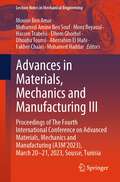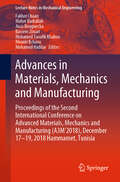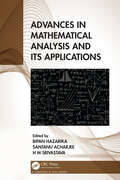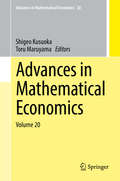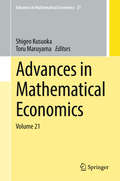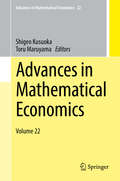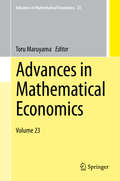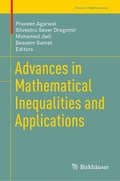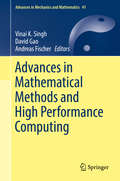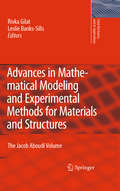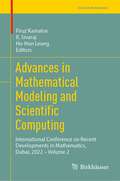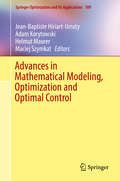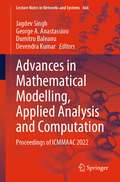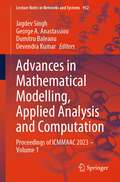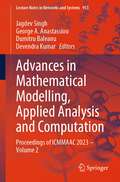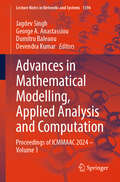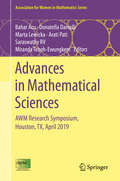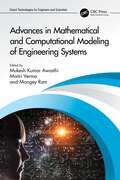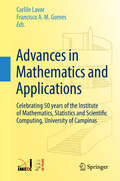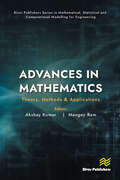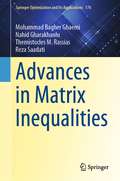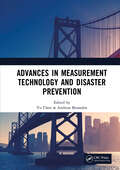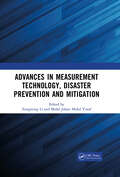- Table View
- List View
Advances in Materials, Mechanics and Manufacturing III: Proceedings of The Fourth International Conference on Advanced Materials, Mechanics and Manufacturing (A3M’2023), March 20-21, 2023, Sousse, Tunisia (Lecture Notes in Mechanical Engineering)
by Fakher Chaari Mohamed Haddar Mounir Ben Amar Mohamed Amine Ben Souf Elhem Ghorbel Aberrahim El Mahi Moez Beyaoui Hassen Trabelsi Dhouha TounsiThis book reports on innovative materials research with a special emphasis on methods, modeling, and simulation tools for analyzing material behavior, emerging materials, and composites, and their applications in manufacturing and automotive, among others. It gathers the proceedings of the fourth International Conference on Advanced Materials Mechanics and Manufacturing, A3M2023, held on March 20-21, 2023, in Sousse, Tunisia, and organized by the Laboratory of Mechanics, Modeling, and Manufacturing (LA2MP) of the National School of Engineers of Sfax. The book covers findings from experimental analyses and numerical simulations of material behavior, characterization of new materials, structures and composites, optimization methods and Artifical Intelligence applications. Offering a good balance of fundamental research and practice-oriented findings, it provides researchers and professionals with a timely snapshot of engineering methods in mechanics, materials and manufacturing.
Advances in Materials, Mechanics and Manufacturing: Proceedings of the Second International Conference on Advanced Materials, Mechanics and Manufacturing (A3M’2018), December 17–19, 2018 Hammamet, Tunisia (Lecture Notes in Mechanical Engineering)
by Fakher Chaari Mohamed Haddar Maher Barkallah Anas Bouguecha Bassem Zouari Mohamed Taoufik Khabou Mounir KchaouThis book reports on cutting-edge findings concerning characterization of material behavior, material modeling and simulation, and applications in the field of manufacturing. Based on the second International Conference on Advanced Materials Mechanics & Manufacturing, A3M2018, organized by the Laboratory of Mechanics, Modeling and Manufacturing (LA2MP) of the National School of Engineers of Sfax, Tunisia, the book covers a variety of topics, such as experimental analysis of material plasticity and fatigue, numerical simulation of material behavior, and optimization of manufacturing processes, such as cutting and injection, among others. It offers a timely snapshot on current research and applications, offering a bridge to facilitate communication and collaboration between academic and industrial researchers.
Advances in Maternal-Fetal Biomedicine: Cellular and Molecular Mechanisms of Pregnancy Pathologies (Advances in Experimental Medicine and Biology #1428)
by Marcelo Gonzalez-OrtizThis edited volumeaims to describe physiological and pathophysiological mechanisms that underlie human maternal-fetal interactions. The book emphasizes the structure and development of the fetoplacental unit, the endocrine and nutritional regulation of fetal development, nitric oxide signalling, solute carriers function and ion channels regulation in healthy pregnancies and diseases, like preeclampsia, gestational diabetes, and maternal obesity, among others. Also, we highlight novel mechanisms associated with language impairment in children, the use of serotonin inhibitors or cannabis during pregnancy, and maternal conditions' potential impact on cerebrovascular development in newborns and infants. The cellular and molecular understanding of maternal-fetal physiology and pathophysiology will allow the readers to understand the impact of diseases or conditions that are highly prevalent in pregnant women.
Advances in Mathematical Analysis and its Applications
by H. M. Srivastava Bipan Hazarika Santanu AcharjeeAdvances in Mathematical Analysis and its Applications is designed as a reference text and explores several important aspects of recent developments in the interdisciplinary applications of mathematical analysis (MA), and highlights how MA is now being employed in many areas of scientific research. It discusses theory and problems in real and complex analysis, functional analysis, approximation theory, operator theory, analytic inequalities, the Radon transform, nonlinear analysis, and various applications of interdisciplinary research; some topics are also devoted to specific applications such as the three-body problem, finite element analysis in fluid mechanics, algorithms for difference of monotone operators, a vibrational approach to a financial problem, and more. Features: The book encompasses several contemporary topics in the field of mathematical analysis, their applications, and relevancies in other areas of research and study. It offers an understanding of research problems by presenting the necessary developments in reasonable details The book also discusses applications and uses of operator theory, fixed-point theory, inequalities, bi-univalent functions, functional equations, and scalar-objective programming, and presents various associated problems and ways to solve such problems Contains applications on wavelets analysis and COVID-19 to show that mathematical analysis has interdisciplinary as well as real life applications. The book is aimed primarily at advanced undergraduates and postgraduate students studying mathematical analysis and mathematics in general. Researchers will also find this book useful.
Advances in Mathematical Economics Volume 15 (Advances in Mathematical Economics #20)
by Shigeo Kusuoka Toru MaruyamaA lot of economic problems can be formulated as constrained optimizations and equilibration of their solutions. Various mathematical theories have been supplying economists with indispensable machineries for these problems arising in economic theory. Conversely, mathematicians have been stimulated by various mathematical difficulties raised by economic theories. The series is designed to bring together those mathematicians who are seriously interested in getting new challenging stimuli from economic theories with those economists who are seeking effective mathematical tools for their research.
Advances in Mathematical Economics: Volume 21 (Advances in Mathematical Economics #21)
by Shigeo Kusuoka Toru MaruyamaA lot of economic problems can formulated as constrained optimizations and equilibration of their solutions. Various mathematical theories have been supplying economists with indispensable machineries for these problems arising in economic theory. Conversely, mathematicians have been stimulated by various mathematical difficulties raised by economic theories. The series is designed to bring together those mathematicians who were seriously interested in getting new challenging stimuli from economic theories with those economists who are seeking for effective mathematical tools for their researchers. Members of the editorial board of this series consists of following prominent economists and mathematicians: Managing Editors: S. Kusuoka (Univ. Tokyo), T. Maruyama (Keio Univ. ) Editors: R. Anderson (U. C. Berkeley), C. Castaing (Univ. Montpellier), F. H. Clarke (Univ. Lyon I), G. Debreu (U. C. Berkeleyer), E. Dierker (Univ. Vienna), D. Duffie (Stanford Univ. ), L. C. Evans (U. C. Berkeley), T. Fujimoto (Okayama Univ. ), J. -M. Grandmont (CREST-CNRS), N. Hirano (Yokohama National Univ. ), L. Hurwicz (Univ. of Minnesota), T. Ichiishi (Ohio State Univ. ), A. Ioffe (Israel Institute of Technology), S. Iwamoto (Kyushu Univ. ), K. Kamiya (Univ. Tokyo), K. Kawamata (Keio Univ. ), N. Kikuchi (Keio Univ. ), H. Matano (Univ. Tokyo), K. Nishimura (Kyoto Univ. ), M. K. Richter (Univ. Minnesota), Y. Takahashi (Kyoto Univ. ), M. Valadier (Univ. Montpellier II), M. Yano (Keio Univ).
Advances in Mathematical Economics: Volume 22 (Advances in Mathematical Economics #22)
by Shigeo Kusuoka Toru MaruyamaThe series is designed to bring together those mathematicians who are seriously interested in getting new challenging stimuli from economic theories with those economists who are seeking effective mathematical tools for their research. A lot of economic problems can be formulated as constrained optimizations and equilibration of their solutions. Various mathematical theories have been supplying economists with indispensable machineries for these problems arising in economic theory. Conversely, mathematicians have been stimulated by various mathematical difficulties raised by economic theories.
Advances in Mathematical Economics: Volume 23 (Advances in Mathematical Economics #23)
by Toru MaruyamaThe series is designed to bring together those mathematicians who are seriously interested in getting new challenging stimuli from economic theories with those economists who are seeking effective mathematical tools for their research. A lot of economic problems can be formulated as constrained optimizations and equilibration of their solutions. Various mathematical theories have been supplying economists with indispensable machineries for these problems arising in economic theory. Conversely, mathematicians have been stimulated by various mathematical difficulties raised by economic theories.
Advances in Mathematical Inequalities and Applications (Trends in Mathematics)
by Silvestru Sever Dragomir Mohamed Jleli Bessem Samet Praveen AgarwalThis book is a collection of original research and survey articles on mathematical inequalities and their numerous applications in diverse areas of mathematics and engineering. It includes chapters on convexity and related concepts; inequalities for mean values, sums, functions, operators, functionals, integrals and their applications in various branches of mathematics and related sciences; fractional integral inequalities; and weighted type integral inequalities. It also presents their wide applications in biomathematics, boundary value problems, mechanics, queuing models, scattering, and geomechanics in a concise, but easily understandable way that makes the further ramifications and future directions clear. The broad scope and high quality of the contributions make this book highly attractive for graduates, postgraduates and researchers. All the contributing authors are leading international academics, scientists, researchers and scholars.
Advances in Mathematical Methods and High Performance Computing (Advances in Mechanics and Mathematics #41)
by Vinai K. Singh David Gao Andreas FischerThis special volume of the conference will be of immense use to the researchers and academicians. In this conference, academicians, technocrats and researchers will get an opportunity to interact with eminent persons in the field of Applied Mathematics and Scientific Computing. <P><P>The topics to be covered in this International Conference are comprehensive and will be adequate for developing and understanding about new developments and emerging trends in this area. High-Performance Computing (HPC) systems have gone through many changes during the past two decades in their architectural design to satisfy the increasingly large-scale scientific computing demand. <P><P>Accurate, fast, and scalable performance models and simulation tools are essential for evaluating alternative architecture design decisions for the massive-scale computing systems. This conference recounts some of the influential work in modeling and simulation for HPC systems and applications, identifies some of the major challenges, and outlines future research directions which we believe are critical to the HPC modeling and simulation community.
Advances in Mathematical Modeling and Experimental Methods for Materials and Structures: The Jacob Aboudi Volume (Solid Mechanics and Its Applications #168)
by Leslie Banks-Sills Rivka GilatThis work presents a collection of papers, written by leading authors in honor of Professor Jacob Aboudi. Jacob Aboudi served as Head of the Department of Solid Mechanics, Materials and Structures, as Dean of the Faculty of Engineering and as Incumbent of the Diane and Arthur Belfer Chair of Mechanics and Biomechanics. Aboudi has published more than 200 papers, 2 books and is a leading authority in the field of composite materials. The papers in this volume cover a wide spectrum of topics in the forefront of research in experimental methods and mathematical modeling of materials and structures. Subjects treated include developments in materials science, theoretical and applied mechanics, applied mathematics, applied physics, computational methods in engineering, mechanical and civil engineering. Both theoretical and experimental approaches are presented. As this book reflects the state of the art, possible engineering applications and future research directions are suggested.
Advances in Mathematical Modeling and Scientific Computing: International Conference on Recent Developments in Mathematics, Dubai, 2022 – Volume 2 (Trends in Mathematics)
by R. Sivaraj Firuz Kamalov Ho-Hon LeungThis volume collects the proceedings of the International Conference on Recent Developments in Mathematics (ICRDM), held at Canadian University Dubai, UAE, in August 2022. This is the second of two volumes, with this volume focusing on more applied topics, particularly mathematical modeling and scientific computing, and the first covering recent advances in algebra and analysis. Each chapter identifies existing research problems, the techniques needed to solve them, and a thorough analysis of the obtained results. Advances in Mathematical Modeling and Scientific Computing will appeal to a range of postgraduate students, researchers, and industry professionals interested in exploring recent advancements in applied mathematics.
Advances in Mathematical Modeling, Optimization and Optimal Control (Springer Optimization and Its Applications #109)
by Jean-Baptiste Hiriart-Urruty Adam Korytowski Helmut Maurer Maciej SzymkatThis book contains anin-depth presentation of the plenary talks given from the 16th French--German--Polish Conference onOptimization, held in Kraków, Poland in 2013. Each chapter in this book exhibitsa comprehensive look at new theoretical results and applications inmathematical modeling, optimization, and optimal control. Students andresearchers involved in image processing, partial differential inclusions,shape optimization, optimal control theory and its applications to medical andrehabilitation technology, will find this book valuable. The first chapter by Martin Burger provides an overview ofrecent developments related to Bregman distances, which are vital tool ininverse problems and image processing. The chapter by Piotr Kalita studies theoperator version of a first order in time partial differential inclusion andits time discretization. In the chapter by Günter Leugering, Jan SokoÅ,owski andAntoni Å»ochowski, nonsmooth shape optimization problems for variational inequalitiesare considered. The next chapter, by Katja Mombaur is devoted to applicationsof optimal control and inverse optimal control in the field of medical andrehabilitation technology, in particular in human movement analysis, therapyand improvement by means of medical devices. The final chapter, by NikolaiOsmolovskii and Helmut Maurer provides a survey on no-gap second orderoptimality conditions in the calculus of variations and optimal control, and adiscussion of their further development.
Advances in Mathematical Modelling, Applied Analysis and Computation: Proceedings of ICMMAAC 2022 (Lecture Notes in Networks and Systems #666)
by Dumitru Baleanu George A. Anastassiou Devendra Kumar Jagdev SinghThe book is very useful for researchers, graduate students and educators associated with or interested in recent advances in different aspects of modelling, computational methods and techniques necessary for solving problems arising in the real-world problems. The book includes carefully peer-reviewed research articles presented in the “5th International Conference on Mathematical Modelling, Applied Analysis and Computation”, held at JECRC University, Jaipur, during 4–6 August 2022 concentrating on current advances in mathematical modelling and computation via tools and techniques from mathematics and allied areas. It is focused on papers dealing with necessary theory and methods in a balanced manner and contributes towards solving problems arising in engineering, control systems, networking system, environment science, health science, physical and biological systems, social issues of current interest, etc.
Advances in Mathematical Modelling, Applied Analysis and Computation: Proceedings of ICMMAAC 2023 – Volume 1 (Lecture Notes in Networks and Systems #952)
by Dumitru Baleanu George A. Anastassiou Devendra Kumar Jagdev SinghThis book gathers selected research articles presented in the “6th International Conference on Mathematical Modelling, Applied Analysis and Computation (ICMMAAC)”, held at JECRC University, Jaipur, during August 3–5, 2023. This book is focused on articles dealing with necessary theory and techniques in a balanced manner, and contributes towards solving mathematical problems arising in physics, engineering, chemistry, biological systems, medicine, networking system, control systems, environmental sciences, social issues of current interest and more. Annually held since 2018, the ICMMAAC conference aimed, in particular, to foster cooperation among practitioners and theoreticians in these fields. This proceedings is an invaluable resource for researchers, academicians and professionals associated or interested in current advances in different aspects of mathematical modelling, computational algorithms and analysis necessary for handling real-world problems.
Advances in Mathematical Modelling, Applied Analysis and Computation: Proceedings of ICMMAAC 2023 – Volume 2 (Lecture Notes in Networks and Systems #953)
by Dumitru Baleanu George A. Anastassiou Devendra Kumar Jagdev SinghThis book gathers selected research articles presented in the “6th International Conference on Mathematical Modelling, Applied Analysis and Computation (ICMMAAC)”, held at JECRC University, Jaipur, during August 3–5, 2023. This book is focused on articles dealing with necessary theory and techniques in a balanced manner, and contributes towards solving mathematical problems arising in physics, engineering, chemistry, biological systems, medicine, networking system, control systems, environmental sciences, social issues of current interest and more. Annually held since 2018, the ICMMAAC conference aimed, in particular, to foster cooperation among practitioners and theoreticians in these fields. This proceedings is an invaluable resource for researchers, academicians and professionals associated or interested in current advances in different aspects of mathematical modelling, computational algorithms and analysis necessary for handling real-world problems.
Advances in Mathematical Modelling, Applied Analysis and Computation: Proceedings of ICMMAAC 2024 – Volume 1 (Lecture Notes in Networks and Systems #1394)
by Dumitru Baleanu George A. Anastassiou Devendra Kumar Jagdev SinghThis book is a collection of research papers from the &“7th International Conference on Mathematical Modelling, Applied Analysis and Computation&” organized by Lebanese American University, Beirut, Lebanon from April 18–20, 2024. This proceeding contains research papers related with fundamental mathematical theory and methods in a very suitable manner and useful for handling various contemporary issues of physical, chemical and engineering sciences. The aim of this conference is to foster cooperation among mathematicians and scientists working in these areas. This book is a very useful resource for mathematicians, scientists and engineers working in the field of applied mathematics, analysis and computation for solving real life problems of different domains.
Advances in Mathematical Sciences: AWM Research Symposium, Houston, TX, April 2019 (Association for Women in Mathematics Series #21)
by Bahar Acu Donatella Danielli Marta Lewicka Arati Pati Saraswathy Rv Miranda Teboh-EwungkemThis volume highlights the mathematical research presented at the 2019 Association for Women in Mathematics (AWM) Research Symposium held at Rice University, April 6-7, 2019. The symposium showcased research from women across the mathematical sciences working in academia, government, and industry, as well as featured women across the career spectrum: undergraduates, graduate students, postdocs, and professionals. The book is divided into eight parts, opening with a plenary talk and followed by a combination of research paper contributions and survey papers in the different areas of mathematics represented at the symposium: algebraic combinatorics and graph theory algebraic biologycommutative algebraanalysis, probability, and PDEstopologyapplied mathematicsmathematics education
Advances in Mathematical and Computational Modeling of Engineering Systems (Smart Technologies for Engineers and Scientists)
by Mangey Ram Mukesh Kumar Awasthi Maitri VermaThe text covers a wide range of topics such as mathematical modeling of crop pest control management, water resources management, impact of anthropogenic activities on atmospheric carbon dioxide concentrations, impact of climate changes on melting of glaciers and polar bear populations, dynamics of slow–fast predator-prey system and spread and control of HIV epidemic. It emphasizes the use of mathematical modeling to investigate the fluid flow problems including the breaking of viscoelastic jet, instability arising in nanofiber, flow in an annulus channel, and thermal instability in nano-fluids in a comprehensive manner. This book will be a readily accessible source of information for the students, researchers and policymakers interested in the application of mathematical and computational modeling techniques to investigate various biological and engineering phenomena. Features Focuses on the current modeling and computational trends to investigate various ecological, epidemiological, and engineering systems. Presents the mathematical modeling of a wide range of ecological and environmental issues including crop pest control management, water resources management, the effect of anthropogenic activities on atmospheric carbon dioxide concentrations, and impact of climate changes on melting of glaciers and polar bear population. Covers a wide range of topics including the breaking of viscoelastic jet, instability arising in nanofiber, flow in an annulus channel, and thermal instability in nano-fluids. Examines evolutionary models i.e., models of time-varying processes. Highlights the recent developments in the analytical methods to investigate the nonlinear dynamical systems. Showcases diversified applications of computational techniques to solve practical biological and engineering problems. The book focuses on the recent research developments in the mathematical modeling and scientific computing of biological and engineering systems. It will serve as an ideal reference text for senior undergraduate, graduate students, and researchers in diverse fields including ecological engineering, environmental engineering, computer engineering, mechanical engineering, mathematics, and fluid dynamics.
Advances in Mathematics Education Research on Proof and Proving: An International Perspective (ICME-13 Monographs)
by Andreas J. Stylianides Guershon HarelThis book explores new trends and developments in mathematics education research related to proof and proving, the implications of these trends and developments for theory and practice, and directions for future research. With contributions from researchers working in twelve different countries, the book brings also an international perspective to the discussion and debate of the state of the art in this important area. The book is organized around the following four themes, which reflect the breadth of issues addressed in the book: * Theme 1: Epistemological issues related to proof and proving; * Theme 2: Classroom-based issues related to proof and proving; * Theme 3: Cognitive and curricular issues related to proof and proving; and * Theme 4: Issues related to the use of examples in proof and proving. Under each theme there are four main chapters and a concluding chapter offering a commentary on the theme overall.
Advances in Mathematics and Applications: Celebrating 50 years of the Institute of Mathematics, Statistics and Scientific Computing, University of Campinas
by Carlile Lavor Francisco A. GomesThis book celebrates the 50th anniversary of the Institute of Mathematics, Statistics and Scientific Computing (IMECC) of the University of Campinas, Brazil, by offering reviews of selected research developed at one of the most prestigious mathematics institutes in Latin America. Written by senior professors at the IMECC, it covers topics in pure and applied mathematics and statistics ranging from differential geometry, dynamical systems, Lie groups, and partial differential equations to computational optimization, mathematical physics, stochastic process, time series, and more. A report on the challenges and opportunities of research in applied mathematics - a highly active field of research in the country - and highlights of the Institute since its foundation in 1968 completes this historical volume, which is unveiled in the same year that the International Mathematical Union (IMU) names Brazil as a member of the Group V of countries with the most relevant contributions in mathematics.
Advances in Mathematics: Theory, Methods & Applications (River Publishers Series in Mathematical, Statistical and Computational Modelling for Engineering)
by Mangey Ram Akshay KumarThis book is an excellent collection of various topics of mathematics which include numerical methods, integral equations, and differential equations. The book is recommended to readers to refresh their understanding of applied mathematics with theory and applications. It will be useful to students, researchers, and practitioners working in applied and computational mathematics.
Advances in Matrix Inequalities (Springer Optimization and Its Applications #176)
by Reza Saadati Themistocles M. Rassias Mohammad Bagher Ghaemi Nahid GharakhanluThis self-contained monograph unifies theorems, applications and problem solving techniques of matrix inequalities. In addition to the frequent use of methods from Functional Analysis, Operator Theory, Global Analysis, Linear Algebra, Approximations Theory, Difference and Functional Equations and more, the reader will also appreciate techniques of classical analysis and algebraic arguments, as well as combinatorial methods. Subjects such as operator Young inequalities, operator inequalities for positive linear maps, operator inequalities involving operator monotone functions, norm inequalities, inequalities for sector matrices are investigated thoroughly throughout this book which provides an account of a broad collection of classic and recent developments. Detailed proofs for all the main theorems and relevant technical lemmas are presented, therefore interested graduate and advanced undergraduate students will find the book particularly accessible. In addition to several areas of theoretical mathematics, Matrix Analysis is applicable to a broad spectrum of disciplines including operations research, mathematical physics, statistics, economics, and engineering disciplines. It is hoped that graduate students as well as researchers in mathematics, engineering, physics, economics and other interdisciplinary areas will find the combination of current and classical results and operator inequalities presented within this monograph particularly useful.
Advances in Measurement Technology and Disaster Prevention: Proceedings of the 4th International Conference on Measurement Technology, Disaster Prevention and Mitigation (MTDPM 2023), Nanjing, China, 26-28 May 2023
by Yu Chen Andreas BenardosAdvances in Measurement Technology and Disaster Prevention focuses on research of measurement technology and the development of disaster prevention and mitigation. The topics include: Measurement in Civil Engineering Disaster Prevention and Mitigation Hydraulic Engineering and Surveying Applications Protection Engineering The book will be of interest to professionals and academics in the above-mentioned areas.
Advances in Measurement Technology, Disaster Prevention and Mitigation: Proceedings of the 3rd International Conference on Measurement Technology, Disaster Prevention and Mitigation (MTDPM 2022), Zhengzhou, China, 27–29 May 2022
by Mohd Yusof, Mohd Johari Zongming LiAdvances in Measurement Technology, Disaster Prevention and Mitigation collects papers resulting from the conference on Measurement Technology, Disaster Prevention and Mitigation (MTDPM 2022), Zhengzhou, China, 27–29 May, 2022. The primary goal is to promote research and developmental activities in measurement, disaster prevention and mitigation, and another goal is to promote scientific information interchange between scholars from the top universities, business associations, research centers and high-tech enterprises working all around the world. The conference conducts in-depth exchanges and discussions on relevant topics such as measurement, disaster prevention and mitigation, aiming to provide an academic and technical communication platform for scholars and engineers engaged in scientific research and engineering practice in the field of measurement application, measurement in civil engineering and disaster reduction. By sharing the research status of scientific research achievements and cutting-edge technologies, it helps scholars and engineers all over the world comprehend the academic development trend and broaden research ideas. So as to strengthen international academic research, academic topics exchange and discussion, and promote the industrialization cooperation of academic achievements.
